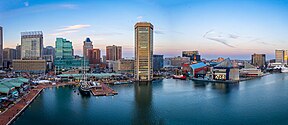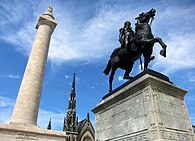
Baltimore
Largest city in Maryland, U.S. / From Wikipedia, the free encyclopedia
Dear Wikiwand AI, let's keep it short by simply answering these key questions:
Can you list the top facts and stats about Baltimore?
Summarize this article for a 10 years old
Baltimore (/ˈbɔːltɪmɔːr/ BAWL-tim-or, locally: /ˌbɔːldɪˈmɔːr/ BAWL-dih-MOR or /ˈbɔːlmər/ BAWL-mər[12]) is the most populous city in the U.S. state of Maryland. With a population of 585,708 at the 2020 census, it is the 30th-most populous city in the United States.[13] Baltimore was designated an independent city by the Constitution of Maryland[lower-alpha 1] in 1851, and today it is the most populous independent city in the nation. As of the 2020 census, the population of the Baltimore metropolitan area was estimated to be 2,838,327, making it the 20th-largest metropolitan area in the country.[14] When combined with the larger Washington, D.C. metropolitan area, the Washington–Baltimore combined statistical area (CSA) has a 2020 U.S. census population of 9,973,383, the third-largest in the country.[14]
Baltimore | |
|---|---|
| Nicknames: | |
| Motto(s): | |
 Interactive map of Baltimore | |
| Coordinates: 39°17′22″N 76°36′55″W | |
| Country | United States |
| State | Maryland |
| City | Baltimore |
| Historic colony | Province of Maryland |
| County | None (Independent city) |
| Founded | August 8, 1729 |
| Incorporated | 1796–1797 |
| Independent city | 1851 |
| Named for | Cecil Calvert, 2nd Baron Baltimore |
| Government | |
| • Type | Mayor–council |
| • Body | Baltimore City Council |
| • Mayor | Brandon Scott (D) |
| • City Council | Council members
|
| • Houses of Delegates | Delegates
|
| • State Senate | State senators
|
| Area | |
| • Independent city | 92.05 sq mi (238.41 km2) |
| • Land | 80.95 sq mi (209.65 km2) |
| • Water | 11.10 sq mi (28.76 km2) 12.1% |
| Elevation | 0–480 ft (0–150 m) |
| Population (2020) | |
| • Independent city | 585,708 |
| • Estimate (2021)[7] | 576,498 |
| • Rank | 76th in North America 30th in the United States 1st in Maryland |
| • Density | 7,235.43/sq mi (2,793.74/km2) |
| • Urban | 2,212,038 (US: 20th) |
| • Urban density | 3,377.5/sq mi (1,304.1/km2) |
| • Metro | 2,844,510 (US: 20th) |
| Demonym | Baltimorean[10] |
| Time zone | UTC−5 (EST) |
| • Summer (DST) | UTC−4 (EDT) |
| ZIP Codes | ZIP Codes[11]
|
| Area codes | 410, 443, and 667 |
| Congressional districts | 2nd, 7th |
| GNIS feature ID | 597040 |
| Website | City of Baltimore |
The land that is now Baltimore was used as hunting ground by Paleo-Indians. In the early 1600s, the Susquehannock began to hunt there.[15] People from the Province of Maryland established the Port of Baltimore in 1706 to support the tobacco trade with Europe, and established the Town of Baltimore in 1729.
During the American Revolutionary War, the Second Continental Congress, fleeing Philadelphia prior to the city's fall to British troops, moved their deliberations to Henry Fite House on West Baltimore Street from December 20, 1776, to February 27, 1777, permitting Baltimore to serve briefly as the nation's capital before the capital returned to Independence Hall in Philadelphia on March 5, 1777. In the mid-18th century, the first printing press and newspapers were introduced to Baltimore by Nicholas Hasselbach and William Goddard.
The Battle of Baltimore was a pivotal engagement during the War of 1812, culminating in the failed British bombardment of Fort McHenry, during which Francis Scott Key wrote a poem that would become "The Star-Spangled Banner", which was eventually designated as the American national anthem in 1931.[16] During the Pratt Street Riot of 1861, the city was the site of some of the earliest violence associated with the American Civil War.
The Baltimore and Ohio Railroad, the nation's oldest railroad, was built in 1830 and cemented Baltimore's status as a major transportation hub, giving producers in the Midwest and Appalachia access to the city's port. Baltimore's Inner Harbor was once the second leading port of entry for immigrants to the United States. In addition, Baltimore was a major manufacturing center.[17] After a decline in major manufacturing, heavy industry, and restructuring of the rail industry, Baltimore has shifted to a service-oriented economy. Johns Hopkins Hospital and Johns Hopkins University are the city's top two employers.[18] Baltimore and its surrounding region are home to the headquarters of a number of major organizations and government agencies, including the NAACP, ABET, the National Federation of the Blind, Catholic Relief Services, the Annie E. Casey Foundation, World Relief, the Centers for Medicare & Medicaid Services, and the Social Security Administration. Baltimore is also home to the Baltimore Orioles of Major League Baseball and the Baltimore Ravens of the National Football League.
Many of Baltimore's neighborhoods have rich histories. The city is home to some of the earliest National Register Historic Districts in the nation, including Fell's Point, Federal Hill, and Mount Vernon. These were added to the National Register between 1969 and 1971, soon after historic preservation legislation was passed. Baltimore has more public statues and monuments per capita than any other city in the country.[19] Nearly one third of the city's buildings (over 65,000) are designated as historic in the National Register, which is more than any other U.S. city.[20][21] Baltimore has 66 National Register Historic Districts and 33 local historic districts.[20] The historical records of the government of Baltimore are located at the Baltimore City Archives.


.jpg/142px-Orioles_Opening_Day_(52803246215).jpg)






